In recent years, many manufacturers of computer power supplies have paid attention to the SFX power supply segment. PSU seat this format usually found in compact, predominantly Mini-ITX cases. Previously, the industry produced SFX power supplies in a case with a length of 100 mm and a power of up to 600 W inclusive, however, the main problem of the vast majority of such solutions was noticeable noise during operation, especially in models with a power of 450 W and above. IN recent times The industry has mastered the production of power supplies with SFX format mounts, but with an increased body length, which made it possible to arrange the elements over a larger area and install a 120 mm fan (albeit a low-profile one). A similar product came out under the Chieftec trademark, and we’ll get acquainted with it now.
The power supply is delivered in a retail package, which is a small box made of thick cardboard with matte printing. The design is dominated by black color, there are also white and yellow elements. The packaging looks quite recognizable, but without frills. There is no adapter for mounting on an ATX format seat.
A power supply unit in a case with matte finish black, which has a very fine texture, which provides high resistance to fingerprints and scratches. A low-profile 120 mm fan is installed under the wire grill.
Characteristics
All the necessary parameters are indicated on the power supply case in full, for the + 12VDC bus power the declared value is 480 W. The ratio of power on the bus + 12VDC to total power is 0.96, which is quite a decent indicator for modern solutions similar power.

Length of wires and number of connectors

| Connector name | Number of connectors | Note |
| 24 pin Main Power Connector | 1 | collapsible |
| 4 pin 12V Power Connector | no | |
| 8 pin SSI Processor Connector | 1 | collapsible |
| 6 pin PCI-E 1.0 VGA Power Connector | ||
| 8 pin PCI-E 2.0 VGA Power Connector | 2 | collapsible, on 1 cord |
| 4 pin Peripheral Connector | 2 | |
| 15 pin Serial ATA Connector | 4 | |
| 4 pin Floppy Drive Connector |
Without exception, all wires are modular, that is, they can be removed, leaving only those that are necessary for a particular system. This is especially true for compact enclosures.
By the standards of full-size power supplies, this model's wires are quite short, but their length is sufficient not only for compact cases, but also for minitower solutions with a bottom-mounted PSU.
The number of connectors is quite sufficient for a compact case, although most typical systems will not be difficult to connect. Another question is that often in such compact systems the drive is, in principle, the only one, and in the case of this power supply unit you still have to use one cord with three connectors, which is not very convenient.
Cooling system

The main semiconductor elements are mounted on two compact radiators with a base thickness of about 3 mm. Independent + 3.3VDC and 5VDC sources are installed on the daughter PCB and, according to tradition, do not have additional heat sinks - this is quite typical for power supplies with active cooling.
All capacitors in the PSU are made by Teapo - again, this is quite typical for mid-budget solutions.

The power supply unit contains a low-profile (15 mm) fan S1201512MW (1800 rpm), 120 mm standard size, based on a sleeve bearing. The fan is manufactured by the Taiwanese company Globefan Technology.
Power supply testing
The first stage of testing is operating the power supply at maximum power long time... Such a test with confidence allows you to make sure that the power supply is working.
In this case, no problems arose, the voltage values \u200b\u200bdeviate slightly from the nominal.
The next step in instrumental testing is construction of cross-load characteristics (KNH) and its representation on a quarter-plane, limited by the maximum power on the 3.3 & 5 V bus on one side (along the ordinate) and the maximum power on the 12 V bus on the other side - along the abscissa. At each point, the measured voltage value is indicated by a color marker depending on the deviation from the nominal value.
| Size designation deviations of output voltages from nominal | ||
| Colour | Deviation range | Qualitative assessment |
| more than five percent | unsatisfactory | |
|---|---|---|
| + 5 percent | badly | |
| +4 percent | satisfactorily | |
| +3 percent | oK | |
| +2 percent | very good | |
| 1 percent or less | excellent | |
| −2 percent | very good | |
| −3 percent | oK | |
| −4 percent | satisfactorily | |
| −5 percent | badly | |
| more than five percent | unsatisfactory | |
It is worth explaining that if there are deviations within three percent, the parameters of the power supply can be considered as being at a good level.
With a typical power distribution across the channels, the deviations in the + 3.3VDC, + 5VDC and + 12VDC channels do not exceed three percent, although at a high load on the + 12VDC channel, the effective voltage value deviates downward relative to the nominal value. Deviations of about four percent are also noticeable at the edges of the power range. Nevertheless, such parameters can be considered quite adequate.
During the next stage of testing, we measure the parameters of the power grid alternating current, to which the investigated power supply unit is connected, when the latter is operating at constant power. Based on the data obtained, parameters are calculated that determine the economy and efficiency of the power supply.
The economy of the model is at a decent level. At maximum power, the power supply dissipates slightly less than 76 W, and 60 W this model dissipates at a power of about 430 watts.
| Work without load | ||
| Mode | I, A | P, W |
| PWR_Off | 0,047 | 0,2 |
| STB | 0,081 | 0,4 |
| Zload | 0,101 | 5,6 |
As for work in lightly loaded and unloaded modes, then everything is very worthy here: in inactive modes, the power supply itself consumes less than 0.5 W, and in active mode it consumes slightly less than 6 W.
The efficiency of the PSU is at a normal level. According to our measurements, the efficiency of this PSU reaches over 87% in the power range from 200 to 400 watts, the maximum recorded value was about 88.2% at 300 watts. At the same time, the efficiency at 50 W was about 81%.
We also measure the inrush current in no-load mode with fully discharged capacitors.
During testing, the power supply was connected with two connectors, which are located on the same power cord. The result obtained demonstrates the ability of the power supply unit to send through the power connectors of the video card full power buses + 12VDC.
Measurement of noise level
In preparing this material, we used the method of measuring the noise level of power supplies, which is still experimental. The power supply unit is placed on a flat surface with a fan upwards, above it, at a distance of 0.35 meters, there is a measuring microphone of the Oktava 110A-Eco sound level meter, which is used to measure the noise level. The power supply is loaded using a special stand, which has silent mode work. During the noise level measurement, the power supply is operated at constant power for 20 minutes, after which the noise level is measured.
This distance to the object of measurement is the closest to a desktop placement system unit with installed power supply. This method allows you to estimate the noise level of the power supply in harsh conditions from point of view short distance from the source of the noise to the user. With an increase in the distance to the noise source and the appearance of additional obstacles with good sound-reflecting ability, the noise level in control point will also decrease, leading to improved acoustic ergonomics in general.
The noise of the power supply when operating in the range up to 200 W inclusive is at a very low level - within 25 dBA from a distance of 0.35 meters. A source with such a noise level can be noticed only at night from a small (less than a meter) distance, and only if you specifically listen, and turn off all the others appliances and closing the windows.
When operating at 275 watts, the power supply noise is at a reduced level relative to typical values \u200b\u200bfor a living room during the day. It is quite comfortable to work against the background of such noise.
When operating at a power of 350 W, the noise level of this model approaches the average value when the PSU is located in the near field. With a more significant removal of the power supply unit and placing it under a table in a case with a bottom-mounted power supply unit, such noise can be interpreted as being below average. In the daytime in a residential building, a source with a similar noise level will not be very noticeable, especially from a distance of a meter or more, and even more so it will be hardly noticeable in an office space, since the background noise in offices is usually higher than in residential buildings. At night, a source with such a noise level will be clearly visible, it will be difficult to sleep nearby. This noise level can be considered comfortable when working at a computer.
At a load of 500 W, the noise of the power supply overcomes the ergonomic level of 40 dBA under the condition of desktop placement, that is, when the power supply is located in the near field in relation to the user. The measured sound pressure level in this mode was about 45 dBA, which is very noisy.
Thus, from an acoustic ergonomics point of view, this model provides comfort with an output power of up to 350 W, demonstrating a truly low noise level in the range of up to 200 W.
We also evaluate the noise level of the power supply electronics, since in some cases it is a source of unwanted overtones. This stage of testing is carried out by determining the difference between the noise level in our laboratory with the power supply turned on and off. If the obtained value is within 5 dBA, there are no deviations in the acoustic properties of the power supply unit. With a difference of more than 10 dBA, as a rule, there are certain defects that can be heard from a distance of about half a meter.
At this stage of measurements, the microphone of the sound level meter is located at a distance of about 40 mm from the upper plane of the power supply unit, since at large distances it is very difficult to measure the noise of the electronics. The measurement is carried out in two modes: standby mode (STB, or Stand by) and when the power supply unit is operating on the load, but with the forcedly stopped fan.
In this case, the noise level of the electronics is quite low and in real operating conditions it will be hardly noticeable, the main contribution to the overall noise level of the power supply is made by a running fan.
Thermal regime
Thermal loading of capacitors is at a low level (60 degrees or less) throughout the studied power range. Thus, the power supply unit is well adapted to work under high load and has a good temperature margin.
Operation at elevated temperatures
At the final stage of testing, we decided to test the operation of the power supply at an elevated ambient temperature, which was 40 degrees Celsius. During this stage of testing, a room with a volume of about 8 cubic meters is heated, after which the temperature of the capacitors and the noise level of the power supply are measured at two ratings: at the maximum power of the PSU and at a power of 125 W.
The power supply unit demonstrated stable operation at maximum power and at an ambient temperature increased to 40 degrees. The noise level under such conditions at maximum power did not change, and at 125 W the noise level increased by 5 dBA from the initial value and amounted to 30 dBA.
As for the temperature of the capacitors, it was 72 degrees (an increase of 14 degrees) when operating at maximum power and 47 degrees (an increase of 11 degrees) when operating at a power of 125 W. Thus, even in such severe conditions, the thermal loading of the capacitors is satisfactory.
Assessment of consumer qualities
Taking into account the format of the power supply unit and its planned use only in compact cases, its consumer qualities can be considered quite decent. The acoustic ergonomics are quite successful, the number of connectors is also sufficient, the electrical characteristics, although not ideal, are in typical modes special claims no to them.
Outcome
The technical and operational characteristics of this model are above average, which is facilitated by quite adequate electrical characteristics, moderate thermal loading, good load capacity of the + 12VDC channel. For the rest of the parameters, the power supply does not stand out in any way from the group of classmates.
Chieftec SFX-500GD-C power supply provided for testing by the manufacturer
Photo added by user. The product may look different.
Attention, this is a photo of a new product. The type and condition of discounted items may vary.
Main characteristics
SFX; fan size 80mm; power: 300W; active PFC; 80 PLUS GOLD standard; power supply MB and CPU: 24 + 4 pin; Molex connectors: 1pc; SATA connectors: 3pcs; without a network cable; color: standard; OEM delivery type
| General characteristics | |
|---|---|
| Form factor Form Factor The version of the ATX and EPS standard that the power supply supports. ATX and EPS specifications characterize the presence of power lines motherboard, processor, video card. | SFX |
| Power Power The maximum output power of the power supply. The most important parameter, the more powerful the power supply, the more high-performance components can be powered from it. | 300 watts |
| Active PFC Active PFC Active Power Factor Correction (PFC) in the power supply. The power factor is the ratio of the power going to useful work to the received one. With an active PFC, the power factor reaches a value between 0.95 and 0.99. | there is |
| Performance (efficiency) Performance (efficiency) Efficiency (ratio of output power to power consumption). The higher given value, the higher the efficiency of the power supply unit and the less power loss. | 87 % |
| Certified in standard Certified in standard The 80 PLUS certification of a power supply means it complies with specific energy efficiency guidelines. With 80 PLUS certification, the efficiency must be at least 80% at 20%, 50% and 100% load, relative to the power supply rating. With the 80 PLUS BRONZE certification, the efficiency must be at least 82% under the same load, relative to the power supply rating. With 80 PLUS SILVER certification, the efficiency must be at least 85% at the same load. With 80 PLUS GOLD certification, the efficiency must be at least 87%. When certified 80 PLUS PLATINUM, the efficiency must be at least 90%. | 80 PLUS GOLD |
| Mean time between failures (MTBF) Mean time between failures (MTBF) Average battery life between repairs. | 100,000 h |
| Connectors | |
| Powering the motherboard and processor The number and type of PSU connectors required to power the motherboard and processor (s). All modern power supplies are powered by the motherboard 24 pin. Depending on the version of the ATX12V standard, the processor power supply can have either one 4 pin connector or two connectors (4 pin + 4 pin) located on the same power line. 8 pin connector according to EPS12V specification is designed to power the motherboard and processor. | 24 + 4 pin |
| Length of supply lines MP Length of supply lines MP The length of the power line is 24 pin from the power supply to the beginning of the connector. | 320 mm |
| Peripheral Connectors (Molex) Peripheral Connectors (Molex) Number of Peripheral (Molex) power supply connectors. | 1 PC |
| SATA connectors SATA Connectors The number of SATA connectors on the power supply. | 3 pcs |
| Connectors for FDD Connectors for FDD Number of 4pin connectors for connecting an FDD drive. | 1 PC |
| Cooling | |
| Fan size (s) Fan size (s) The size of the fan installed in the power supply. With the same performance, a larger fan produces less noise. | 80mm |
| Number of fans Number of fans The number of fans installed in the power supply. Power supplies often have one fan (120 mm or more) located on the bottom wall. But there are power supplies that have a cooling system consisting of 2 or 3 80 mm fans. | one |
| Fan bearing (s) Fan bearing (s) The type of bearing for the fan (s) installed in the power supply. | ball |
| Equipment and dimensions | |
| Dimensions (WxHxD) Dimensions (WxHxD) Overall dimensions of the power supply. ATX power supplies have standard values \u200b\u200bfor width and height. Depth indicates how much space the power supply will take inside the chassis. This information useful for those who plan to install a power supply unit in a small computer case, or consider whether the power supply will block the mounting space for the upper (or lower) case fans. | 63.5 x 100 x 125 mm |
| Network cable included Network cable included The presence of a power supply cable in the delivery kit for connecting it to a home power grid. | absent |
| Delivery type Type of delivery Type of delivery for the power supply. Power supplies with the type of delivery OEM are packed in a bag and usually do not have a mains cable in the kit. Power supplies with delivery type RET are packed in a box and include a power cable, cable ties, screws for fixing to the case and other useful accessories. | OEM |
| Warranty | 36 months |
| Manufacturer country: | China |
The manufacturer reserves the right to change the characteristics of the product, its appearance and completeness without prior notice to the seller.
An offer for the sale of a product is valid for the period that the product is in stock.
Description "Power supply unit SEASONIC SSP-300SFG"
The SEASONIC SSP-300SFG power supply is manufactured in the SFX form factor and has a power of 300 watts. It's great for mid-range devices. The performance of this power supply is quite high at 87%. Moreover, the device is certified according to the 80 PLUS GOLD standard and has an MTBF of 100 thousand hours. The SEASONIC SSP-300SFG power supply has an active PFC and all connectors required for a successful connection to a computer. In particular, these are SATA, Molex and FDD. There are also power connectors for the motherboard and CPU. The motherboard power lines are 320mm long. Cooling of the power supply is provided by a fan with a diameter of 80 mm, running on a ball bearing. The network cable is not included in the delivery.Report an error in the description Sent
POWER SUPPLY STANDARDS
For personal computers, at least six different standard power supplies have been developed throughout their history. Recently, the industry has been producing ATX-based power supplies according to established practice. ATX is an industry specification that requires power supplies to fit into a standard ATX chassis and to be electrically compatible with an ATX motherboard.
In power cables personal computer standardized connectors are used with keys to prevent incorrect switching. In addition, cooling fan manufacturers often equip their products with the same connectors as drive power cables so that they can be easily plugged into a 12-volt supply when needed. Color-coded wiring and industry standard connectors provide the user with a wide range of options when replacing the power supply.
AT standard
The AT standard was first used in computer power supplies. He was born at the same time as the first IBM compatible computers and was used until 1995.
The AT standard power supply provided the computer with four constant voltages - +5, + 12, -5 and -12 V. However, as processors and all kinds of peripherals developed, firstly, the total power consumption of the computer grew, and secondly, the lack of in AT blocks voltage +3.3 V, which had to be obtained directly on the motherboard with a separate stabilizer. In addition, the AT case format was not very convenient for building computers and was not optimized for cooling.
In AT power supplies, the power switch is in the power circuit and is usually brought out to the front of the chassis with a separate wire. Consequently, automatic switching on and shutdown of the computer is impossible.
The AT power supply connects to the motherboard with two identical six-pin connectors that fit into one 12-pin connector on the motherboard. Multi-colored wires go to the connectors from the power supply, and the connection is considered correct when the contacts of the connectors with black wires converge in the center of the motherboard connector.
All this led to the development by Intel in 1995 of the ATX format - a new type of cases and power supplies.
ATX standard
In the ATX power supply, the number of output voltages increased: voltages were added. The latter was introduced to implement functions such as "waking up" a computer on a signal from local network, from the modem, by pressing a key on the keyboard or mouse, as well as to implement the "dormant" S3 Suspend-to-RAM mode, in which all current data is stored in random access memory even when the computer is turned off. Obviously, the +5 V SB voltage must be present regardless of whether the computer is turned on or off (unless, of course, it is physically disconnected from the outlet), therefore its stabilizer is practically a separate miniature low-power power supply unit that operates continuously. If in the AT format the computer power button removed the voltage of 220 V from the power supply, then in ATX the power button only gives the power supply a command to stop the PWM controller of the main stabilizer, but the unit itself remains connected to the network, and the duty stabilizer continues to work in it +5 V SB mode. In order to turn off the unit completely, you either need to use the one available on many models, or physically disconnect it from the 220 V.
Gradually, changes were made to the ATX standard, but until a certain point they did not significantly affect the power supply. A new trend, which led to a noticeable change in the power supply from the user's point of view, was the switch to 12-V power supply of the processor stabilizer.
ATX12V
Before release by the company Intel processor A Pentium 4 with significant power consumption, the usual solution was to supply the processor regulator with a + 5V bus. It is obvious that for a processor with a power consumption of, say, 50 W, even without taking into account the losses on the stabilizer located on the motherboard (and this is at least 10% more), the current when powered from the mentioned bus will be 10 A, which is quite a lot. Such currents, firstly, complicate the placement of components on the motherboard, because it is often difficult to place a large ATX power connector in a convenient place for the PCB designer (as close as possible to the processor power supply regulator), and secondly, insufficient contact in the power connector the system board caused overheating of the pins and connector with further deterioration of contact and more than likely system failures. The way out of this situation was the transition to the power supply of the CPU stabilizer from the + 12V bus. It is known that if the voltage is 2.4 times higher, then the current with the same power consumption will be 2.4 times less, and, in addition, the stabilizer installed on the board, like any converter direct current, increases its efficiency with increasing input voltage. However, another problem arose: since until recently there were no serious +12 V consumers on the motherboard, only one wire for this voltage was provided in its power connector, which could lead to overheating and burning of the contacts due to excessive current through them ... This problem was solved by the addition of one more motherboard power connector - a small four-pin ATX12V, which not only added two additional + 12V wires, but also, due to its modest size, made it possible to place it next to the processor power regulators, seriously simplifying the work of developers printed circuit boards... Thus, in the summer of 2000 intel released an engineering addition to the ATX 2.03 standard called "ATX12V". In addition to the aforementioned connector, the requirements for the power supply were tightened in it: with the same total output power as before, the unit had to provide high currents on the buses +12 and +3.3 V. Moreover, the lower limit of the maximum current for +12 V bus - 10 A regardless of the total power of the PSU; a unit that does not provide this current cannot be considered ATX12V compliant.
Since physically the new units differed from the old ones only by an additional connector, various adapters for adapting ATX power supplies to the ATX12V standard appeared on sale in large quantities. Of course, due to the increased requirements for load currents for powerful systems, such an adaptation was incorrect, but systems with relatively low power consumption did not have any problems.
The next noticeable change was brought by version 1.2 of the same ATX12V standard. The voltage -5 V, until this moment mandatory for all power supplies, was practically not used anymore: it was supplied only to the motherboard and ISA connectors, which have already sunk into oblivion. Even in older computers that still used ISA cards, this voltage was usually not required. In this regard, in the ATX12V 1.2 standard, the voltage of -5 V became optional, and soon power supplies appeared on the market, which did not have a corresponding wire in the mainboard power connector.
In the meantime, a new tendency has emerged: if before the consumption on the +3.3 V bus grew, now, on the contrary, it began to fall, because more and more manufacturers began to use separate stabilizers on their motherboards, powered by +5 or more often +12 V and forming voltage required for the board. Moreover, modern graphics cards are no longer powered by AGP, but from a separate power connector, which simply does not run the +3.3 V voltage. Accordingly, the requirements for this voltage are falling, and the load capacity on the +12 V bus, on the contrary, are increasing, especially given the ever-increasing power consumption of processors.
ATX12V 2.0
To meet the above requirements, the ATX12V standard, version 2.0 was developed (not to be confused with the ATX 2.0 standard; ATX12V 2.0 corresponds to version 2.2 of the ATX standard). These are not just cosmetic improvements to the PSU: the changes are quite serious, and the old PSUs, although they will be partially compatible with ATX12V 2.0 mainboards, will have to be replaced in many cases.
The main difference between the new standard is that now two + 12V buses are provided in the power supply unit at once. This is due to the fact that it is impossible to increase the load current on one bus above 20 A - according to the safety standards, the power of the circuits to which there is open access for the operator, should not exceed 240 V-A (12 Vx20 A). At the same time, the maximum load currents on the +3.3 and +5 V buses have noticeably decreased (up to one and a half times compared to ATX12V 1.1 units of the same power).
The motherboard power connector has also undergone changes. If earlier it was a 20-pin Molex 39-01-2200 connector, now it has been replaced by - added each contact +12, +3.3, +5 V and "ground". It is easy to see that the twenty extreme pins of both connectors are exactly the same, so an ATX12V 2.0 power supply can be used in tandem with an ATX12V 1.1 board (if there is free place for four "extra" pins of the connector) and vice versa, but in the latter case it should be borne in mind that a power supply corresponding to the old standard may not cope with a powerful ATX12V 2.0 system with high power consumption.
The familiar four-pin ATX12V connector, designed to power the processor stabilizer, has not changed in the new standard, but now it is supplied with +12 V voltage from another source, so the processor has its own power supply, to some extent independent of the power supply of the motherboard and various peripherals , which should have a positive effect on the quality of supply voltages.
Also, the -5 V voltage has completely disappeared from the new standard: it is not even provided as optional. Together with it, the AUX connector that appeared several years earlier in the ATX 2.01 standard for additional powering of the motherboard disappeared (+5 and +3.3 V voltages were output to it, and the connector itself resembled the power connectors of AT form factor motherboards); Despite the recommendation to use it in systems with high power consumption, in practice motherboards with such a connector were practically not produced. In addition, it has now become mandatory, however, the latest models of ATX12V 1.1 power supplies have already been produced with them.
It is also worth noting the appearance in the standard of recommendations on maximum load currents for power supplies with a power of 350 and 400 W - before that currents for power supplies up to 300 W inclusive were regulated, which left the manufacturers of more powerful power supplies more room for choosing characteristics, and this, in turn, led to the fact that high-power units greatly varied among themselves in capabilities, and some did not even surpass the standard 300 W power supply in everything.
Standard E
P
S12V
Generally speaking, EPS12V is the standard for entry-level servers.Often enoughmeet on sale the corresponding power supplies with a power of 400-500 W, which are of certain interest for owners of powerful systems of the ATX standard.
Physically, blocks of the EPS12V standard are compatible with ATX blocks in terms of size and location of mounting holes, so nothing prevents them from being installed in a regular ATX case. The power connector of a motherboard of EPS12V standard is similar to that in ATX12V 2.0-boards, and not only physically (this is a 24-pin connector of the same type), but also in the pinout; Thus, you can easily connect ATX12V 2.0 motherboards to the EP512V power supply and, if there is a physical possibility, connect a larger connector to ATX12V 1.1 boards (if this is not possible, use an adapter). The EPS12V has its own eight-pin processor power connector. However, the four outer pins are exactly the same as the ATX12V connector, so it can also be directly connected to a regular ATX12V motherboard if there is free space on the side of the connector installed on it, or if there is no space, use an adapter.
It is important that EPS12V units are available with one + 12V source, and with two, similar to ATX12V 2.0. In the latter case, you can connect the second +12 V power supply on the ATX12V 1.1 motherboard (it is routed to the 8-pin processor power connector) only if you are sure that the processor power buses and the +12 V bus from the motherboard power connector are completely separated ; otherwise, the system board may be damaged. With ATX12V 2.0 mainboards, this problem cannot arise - their buses are separated by definition, since they use two separate power supplies.
Compact power supplies
If during the evolution of the standards for full-size cases, AT, ATX, BTX, only the contents have changed in the corresponding power supplies, and not the appearance, and any AT form factor unit released a decade ago in terms of dimensions and location of mounting holes will fit the latest ATX- or BTX- case, then in the area of \u200b\u200bpower supplies for compact cases the situation is exactly the opposite. These units inherit electrical parameters and connectors for connecting powered devices from their full-size counterparts (with the only exception that the power of compact units is usually less), but the desire in each case to place the power supply in the case so as to minimize the space it occupies and, accordingly the overall size of the chassis has led to the emergence of eight different standard chassis types for compact power supplies, each of which better suits the requirements of any particular system. The full-size ATX power supply familiar to most users, the largest (see the table at the end of the page), has the shape of a regular rectangular parallelepiped and can be equipped with one or two fans ranging in size from 80 to 120 mm.
SFX standard (S - Small), the oldest standard for compact power supplies, describes five different designs. First, there are two low-profile blocks, 100 mm wide and 50 and 63.5 mm high. The names of these models are given not by their dimensions, but by the sizes of the fans installed in them - 40 # and 60 # mm, respectively. Such fans provide a fairly weak air flow that can only cool the power supply itself, therefore, in computers where the power supply is also tasked with cooling the entire system unit, it is recommended to use the following two options, with 80 mm fans located on the top cover. The height of the end wall of both blocks is 63.5 mm, but the fan protrudes beyond the lid by another 17.1 mm, so the maximum block height is a little more than 8 cm. These two form factors differ only in that the first has a width of 100 mm and a depth 125 mm, while the second has the opposite. The last version of the SFX block is the so-called PS3. This is a version of the full-size ATX unit shortened by several centimeters. PS3 blocks are quite common in microATX cases.
TFX standard(T is Thin, thin) , describes only one version of the power supply, in a thin but very long (175 mm) case. The unit is equipped with a powerful 80 mm fan and therefore can be used to cool the entire system. At the same time, unlike SFX units with the same fan, the latter does not protrude beyond the lid, thanks to which TFX combines the advantages of low-profile SFX and SFX with a powerful fan.
CFX standards (C - Compact) and LFX (L - Lowprofile), recently developed specifically for BTX systems. CFX power supplies are designed for compact systems with a chassis volume of 10-15 liters (this is less than many modern microATX cases), one of such units is shown on. The CFX block is a further development of the PS3 version of the SFX: it has a slightly reduced depth, and the body is L-shaped. In the assembled system, such a block will hang over motherboard, which reduces the width of the computer case by a few centimeters. The LFX form factor power supplies are the smallest for today and are designed for ultra-compact BTX systems with a total chassis volume of 6-9 liters. The width and height of these blocks are less than those of the TFX (of course, we had to pay for this with the size of the fan placed on the side wall of the block - it cannot be more than 70 mm). At the same time, the block length increased to 210 mm, but this is partially compensated by the fact that at the last 58 mm the block height decreases from 72 to 46 mm. In addition, this length is the maximum allowable, but if technological capabilities allow, then the manufacturer has the right to shorten the LFX up to 152 mm.
Power supply form factors
| Form factor | Block dimensions, mm | Fan size, mm |
| ATX | 150*86*146 | 80, 90 or 120 |
| SFX (40 mm profile) | 100*50*125 | 40 |
| SFX (60 mm profile) | 100*63,5*125 | 60 |
| SFX (top mount fan) | 100*63,5 + 17,1*125 | 80 |
| SFX (reduced depth) | 125*63,5 + 17,1*100 | 80 |
| SFX (PS3) | 150*86*101,4 | 80 |
| TFX | 65*85*175 | 80 |
| CFX | 150*86*95 | 80 |
| LFX | 62*72*210 | 70 |
Questions
- Ryzen Threadripper 1950X 3.4Ghz 16core 40Mb 14nm "\u003e Ryzen Threadripper 1950X 3.4Ghz 16core 40Mb 14nm
- Ryzen Threadripper 1920X 3.5Ghz 12core 38Mb 14nm "\u003e Ryzen Threadripper 1920X 3.5Ghz 12core 38Mb 14nm
- An inexpensive tablet should be like this
You can mark fragments of text you are interested in,
which will be available through a unique link in the browser address bar.
Five SFX PSUs Test: 300W SilverStone, Seasonic, FSP, Power Man and Winsis
Lax (NAVAHU) 12/04/2013 06:00 Page: 1 of 4 | | version for print | | archive
- P. 1: Introduction by Tester: SilverStone SST-ST30SF, Seasonic SS-300SFD
- P. 2: Tester: FSP300-60GHS, Power Man IP-S300BN1-0, Winsis WMS-300SFX
- P. 3: Brief TX, test bench, tools and methodology, test results: SilverStone, Seasonic, FSP, Power Man
- P. 4: Test results: Winsis, summary results, conclusion
Introduction
Gradually, BP tests according to the new mass method are moving into the category of traditional ones. In the course of these studies, many solutions with a capacity of 450, 500, 550, 600, 650, 700, etc. have already been considered. There are over thirty blocks in total - a long list! However, in all these power categories, only models have been presented to date.
It's time to move on to learning about compact devices. Moreover, there are almost no tests of blocks of the SFX form factor in runet, and I have not come across large-scale comparisons involving several models at all, so this topic is very relevant.
Among the power supplies intended for compact computers, there are many specific and low-power (150-180 W) models that do not fit well with our testing methodology and are unlikely to be of interest to readers-overclockers. That's why it was decided to start with 300-watt units for the beginning. In theory, their capabilities are sufficient even for a mid-range gaming PC. So, I personally happened to observe the system with GeForce GTX 670 and Intel Core i7-4770, overclocked to 4.3 GHz (!), which worked just fine from a small-format 300-watt power supply unit.
So, after choosing the category "SFX-blocks with a power of 300 W", the question remains - what can the Moscow retail offer us? After combing the assortment, it turned out that only five models are available to customers today! Not much, but the more interesting and meaningful the review will be, because the laboratory managed to get the site everything these blocks: SilverStone SST-ST30SF, Seasonic SS-300SFD, FSP 300-60GHS, Power Man IP-S300BN1-0, Winsis WMS-300SFX.
Test participants
SilverStone SST-ST30SF
First on the list is the SilverStone SST-ST30SF block. It is not quite usual for of this class a model that has many features inherent in more full-size ATX solutions.
The PSU comes in a small cardboard box (240 x 175 x 75 mm). Looking ahead, I note that this is the only subject who was presented for the test in a "boxed" version, all the rest are pure OEM (which, in general, is typical for such devices).

It is clear that this provides the model with better safety during transportation, moreover, the box (in the best traditions of SilverStone) contains comprehensive information about the product: photo, description, list of connectors, table of power characteristics.

In addition, the unit has a good package bundle, which rivals cannot boast of.
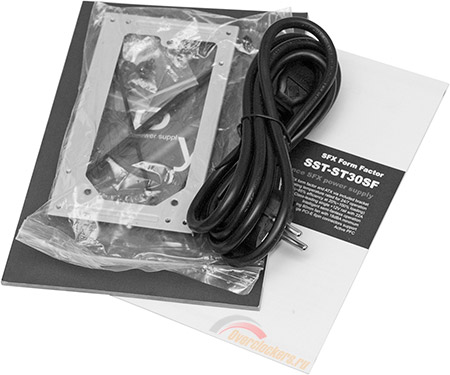
In addition to instructions, a power cord and plastic ties, a special frame was found in the box that allows you to install the power supply unit in a standard-format case designed for full-size ATX models.
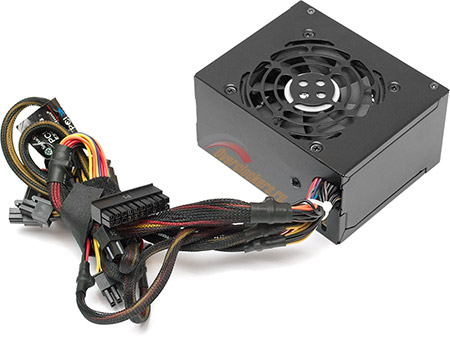
The dimensions of the device are 125 x 100 x 63 mm (which corresponds to the specifications of the SFX standard), the weight is 880 g. The case is painted black (this should be noted separately, since the rest of the models in our set were left unpainted).

SilverStone SST-ST30SF is equipped with a power off button. For all units of this class that came to us for testing, the grill covering the fan is not removable:

The size of the small fan is 80 x 20 mm (like other test participants). The real diameter of the nine-blade impeller is ~ 72 mm.
The power label indicates that the maximum load during long-term use of the unit cannot exceed 300 W. Apparently, the short-term "peak" can be higher, but within the framework of the methodology, the unit will be tested only at 250 W. The current on the 12 V line can reach 22 A, which corresponds to a power of 264 W. This is 88% of the nominal value of the device - a very good indicator.

The limit on the total load on the 3.3 V and 5 V lines is 103 W, while the current on the first cannot exceed 21 A, on the second - 20 A. The unit is equipped with an 80 Plus Bronze efficiency certificate, which is more typical for full-size PSUs.
All unit cords are equipped with a plastic sheath. To power the motherboard, use the ATX Mainboard 20 + 4-pin connector (cord length 310 mm), to power the processor - CPU 4 + 4-pin connector (cord length - 410 mm).

The unit is equipped with a PCI-e 6-pin connector for powering the video card. At first glance, "not a lot", but none of the competitors have this either! In this way, this feature Silver Stone models should be considered a definite plus.

One of the peripheral power cords has three SATA connectors, the other has two Molex connectors and one connector for connecting a Floppy drive (the length of the first cord is 600 mm, the second is 700 mm).
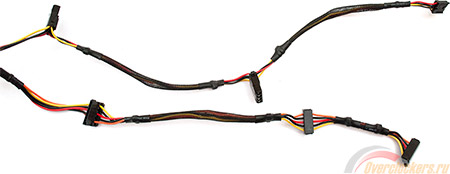
In general, SilverStone SST-ST30SF has everything like "adult" ATX, in fact for this reason, and it was decided to start with it, so that readers can see the contrast with more typical SFX-models.
Seasonic SS-300SFD
Seasonic power supply case has an unusual shape. The fan is, as it were, placed in its own compartment:

Unfortunately, this should be noted as a noticeable disadvantage of this model, because it does not comply with the SFX standard. The dimensions of the device are 125 x 100 x 76 mm, the weight is 1120 g. The unit is equipped with a power off button.
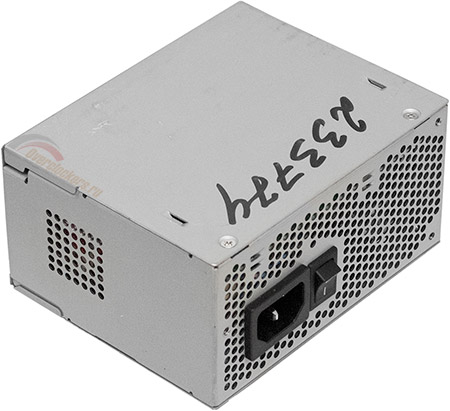
The standard size of the fan is the same - 80 x 20 mm, the actual diameter is ~ 72 mm. But in terms of the number of blades (there are seven of them here) and the shape of the impeller, it differs from that installed on the SilverStone power supply unit (I note this, since the nine-blade fans of the rest of the test subjects look almost the same).

It is not entirely clear to me the reason why the 12 V line of this unit is divided into two virtual components. The current strength on one of them can reach 14.5 A, on the other - only 8 A. In total, this gives 22.5 A or 270 W of power. Everything is fair here, the manufacturer indicated this maximum load on the sticker. This is 90% of the device's rating - a good indicator.

The total power that can be supplied on the 3.3 V and 5 V lines is 125 W. The amperage on each of these lines is limited to 20 A. The unit is 80 PLUS certified.
A full-fledged ATX Mainboard 20 + 4-pin connector (cable length - 320 mm) is provided for powering the motherboard, but for powering the processor, unlike the SilverStone unit, the manufacturer decided to use only a single 4-pin CPU (cable length - 320 mm) ... Not the best option, some modern motherboards may not start when such a power supply unit is connected.
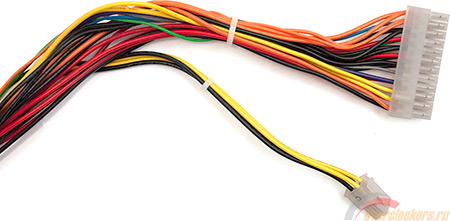
In terms of the number of Molex connectors, this block bypasses the SilverStone product - there are four such connectors at once (plus a couple of connectors for Floppy drives, which is clearly redundant). The length of the cords is 650 mm.







